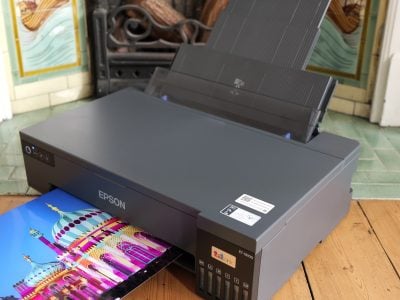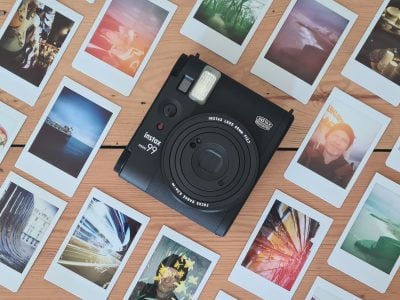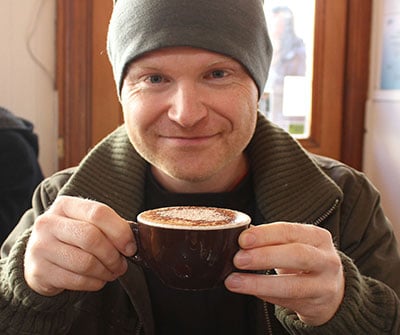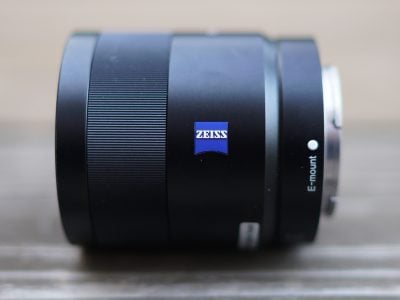Sony FE 55mm f1.8 ZA review
-
-
Written by Thomas
Quality
Testing: Longitudinal Chromatic Aberration and focus shift
Lenses with focal ratios of f2.8 or larger are often prone to longitudinal color aberrations (loCA, a.k.a. “axial color” or “Bokeh CA”). These normally show up as magenta coloration in the foreground and greenish hues in the background and are not easily corrected in post-processing. But the Sony FE 55mm f1.8 ZA is pretty good in this respect: it shows only little loCA wide open. The following 100% crops show the foreground on the left and the background on the right with the first crop at f1.8, second at f2.0, third at f2.8:
Longitudinal Chromatic Aberration (loCA)
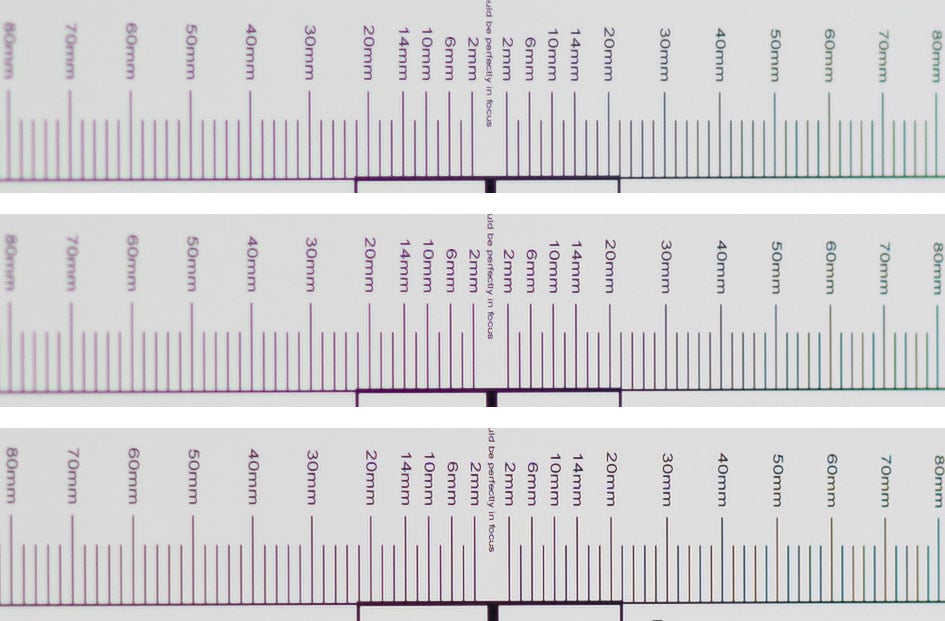
Above: Sony FE 55mm f1.8 ZA at f1.8, f2.0, f2.8; 100% crops
The test also reveals that there is no discernible focus shift. For comparison have a look at the Sigma 50mm f1.4 Art (here), the Sony FE 50mm f1.4 ZA (here), and the Sony FE 50mm f1.8 (here).
Sharpness and contrast
Let’s have a look at the theoretical performance of the Sony FE 55mm f1.8 ZA first and compare it to some alternatives from Sony and Sigma:

Above: MTF Sony FE 55mm f1.8 ZA (left), Sony FE 50mm f1.8 (right)
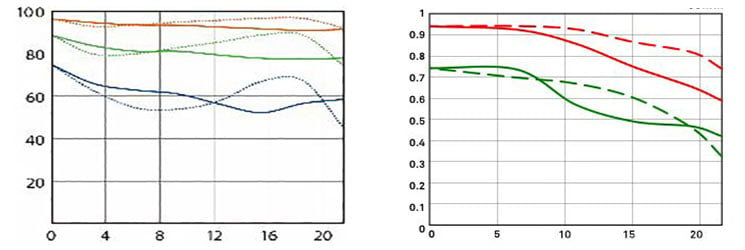
Above: MTF Sony FE 50mm f1.4 ZA (left), Sigma 50mm f1.4 Art (right)
The MTF charts of the Zeiss-designed Sony ZA lenses shows the contrast wide open at 10 line-pairs per mm (in red), 20 lp/mm (green) and 40 lp/mm (blue). Higher values are better (more contrast) and the closer the solid and the dotted lines are together the less astigmatism (= resolution depends on the orientation of the test-pattern) the lens has. The MTF chart for the Sony FE 50mm f1.8 shows 10 and 30 lp/mm at f1.8 in green and at f8 in red. So it’s best to ignore the red lines in that chart for the comparison. The Sigma Art shows 10 lp/mm (red) and 30 lp/mm (green) at f1.4. The x-axis displays the distance from the optical axis (=center of the sensor) in mm.
From the charts the Sony FE 55mm f1.8 ZA looks very good with a very even performance within the APS-C image-circle. Sharpness and contrast then drops off towards the full-frame corner but from the charts the FE 55mm f1.8 ZA still looks better than the FE 50mm f1.8 and the Sigma Art. Only the Sony FE 50mm f1.4 ZA shows better performance in the full-frame corner. But let’s see how this theoretical performance of the lenses translates into real life results in the sharpness test based on Siemens-stars at 4 mm (center), 13 mm (APS-C-corner), and 20 mm (FF-corner) off axis. Processing was done in Lightroom 8/CRAW 11 from RAW to Adobe Color profile. Noise-reduction is set to 0, sharpening to 50/0.5/36/10, with no extra tone, color, or saturation adjustment. White-balance was adjusted to a neutral white and I did some exposure compensation to make the brightness of all crops match. So you will not see light fall-off in the corners.
The following 100% crops show the Sony FE 55mm f1.8 ZA shot on a 42MP Sony A7R II from f1.8 down to f11.
Sony FE 55mm f1.8 ZA; 100% crop from center, APS-C/DX-corner, FF/FX-corner

Above: Sony FE 55mm f1.8 ZA at f1.8

Above: Sony FE 55mm f1.8 ZA at f2.0

Above: Sony FE 55mm f1.8 ZA at f2.8

Above: Sony FE 55mm f1.8 ZA at f4.0

Above: Sony FE 55mm f1.8 ZA at f5.6

Above: Sony FE 55mm f1.8 ZA at f8.0

Above: Sony FE 55mm f1.8 ZA at f11
These 100% crops directly from a 42MP Sony A7R II sensor show very good performance already at f1.8. The FF-corner is a tad softer but nothing to complain about and it improves nicely when stopped down to f2.8. The lens also shows only very little field-curvature.
The following comparison shows the Sony FE 55mm f1.8 ZA, Sony FE 50mm f1.4 ZA, Sigma 50mm f1.4 Art, and Sony FE 50mm f1.8 at f1.8. The Sigma Art was shot on a 46MP Nikon Z7 (mounted via Nikon’s FTZ adapter). Linear resolution of the Nikon Z7 sensor is only 4% higher than from the Sony A7R II sensor which favors the Sony lenses a bit in this comparison but should not make a distinct difference:
Sony FE 55mm f1.8 ZA; comparison with other lenses at f1.8

Above: Sony FE 55mm f1.8 ZA at f1.8

Above: Sony FE 50mm f1.4 ZA at f1.7

Above: Sigma 50mm f1.4 Art on a Nikon Z7 at f1.8

Above: Sony FE 50mm f1.8 at f1.8
In this comparison the Sony FE 50mm f1.4 ZA and the Sigma Art are the sharpest in the center followed closely by the Sony FE 55mm f1.8 ZA and the FE 50mm f1.8. In the APS-C-corner the Sony FE 55mm f1.8 ZA is the best followed by the FE 50mm f1.8, the FE 50mm f1.4 ZA, and the Sigma Art. In the FF-corner the Sony FE 50mm f1.4 ZA and the FE 55mm f1.8 ZA are amazingly clear while the Sigma Art and the FE 50mm f1.8 are much softer.
Performance at long distances
The Siemens-star test-targets are shot at a distance of 45x focal length (i.e. at around 2.3m). But as performance of lenses also depends on the shooting distance I did another series of test-shots of a city around 1 km away. Processing was done in Lightroom 8/CRAW 11 from RAW to Adobe Color profile with the lens-profile automatically applied. Noise-reduction is set to 0, sharpening to 50/0.5/36/10, with no extra tone, color, or saturation adjustment. I used autofocus at the largest aperture and did not change focus for other apertures. All shots of the Sony FE 55mm f1.8 ZA were made on a 42MP Sony A7R II at ISO 100 and image stabilization switched off.
The main image shows the complete scene wide open to give you an impression of the angle of view and to judge vignetting. Following the main image are 100% crops from the Sony FE 55mm f1.8 ZA from the center, the APS-C-corner and the FF-corner down to f11. You can access the respective full resolution shots up to f11 via the links beneath the main image or by clicking on the respective crops. Please respect our copyright and only use those images for personal use.
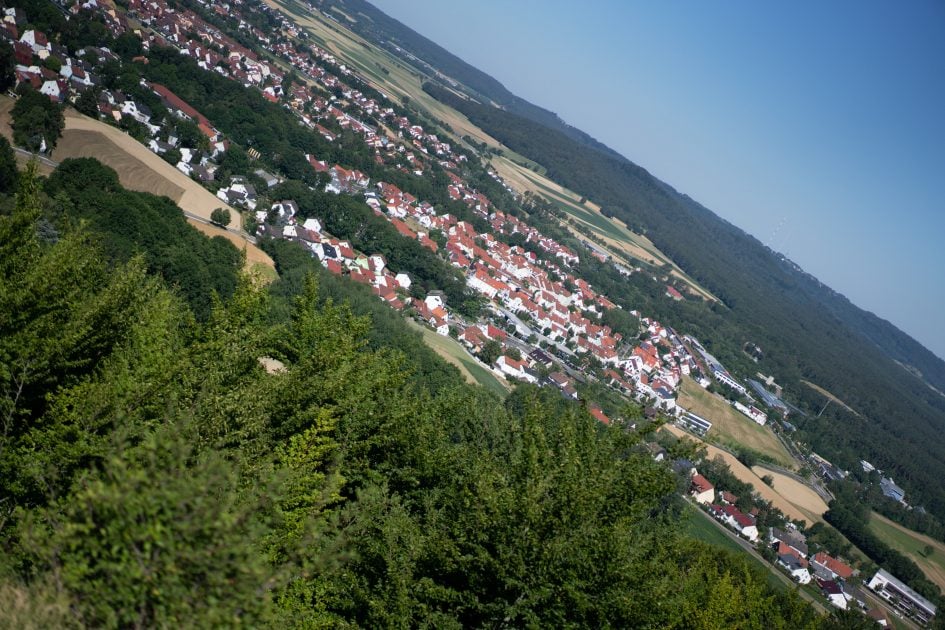
Above: Sony FE 55mm f1.8 ZA at f1.8; click image for 4k version, also available as large original at f1.8, f2.0, f2.8, f4.0, f5.6, f8.0, f11

Above: Sony FE 55mm f1.8 ZA at f1.8; 100% crop from center, APS-C-corner, FF-corner

Above: Sony FE 55mm f1.8 ZA at f2.0; 100% crop from center, APS-C-corner, FF-corner

Above: Sony FE 55mm f1.8 ZA at f2.8; 100% crop from center, APS-C-corner, FF-corner

Above: Sony FE 55mm f1.8 ZA at f4.0; 100% crop from center, APS-C-corner, FF-corner

Above: Sony FE 55mm f1.8 ZA at f5.6; 100% crop from center, APS-C-corner, FF-corner

Above: Sony FE 55mm f1.8 ZA at f8.0; 100% crop from center, APS-C-corner, FF-corner

Above: Sony FE 55mm f1.8 ZA at f11; 100% crop from center, APS-C-corner, FF-corner
The Sony FE 55mm f1.8 ZA is amazingly clear across the full-frame sensor in this long distance test at f1.8 already. Stopping down to f2.8 gets rid of some magenta/green outlining around high-contrast edges and improves center-sharpness to excellent.
The following comparison shows the Sony FE 55mm f1.8 ZA, Sony FE 50mm f1.4 ZA, Sigma 50mm f1.4 Art, and Sony FE 50mm f1.8 at f1.8. All lenses were shot at the same day within minutes. Only the Sony FE 55mm f1.8 ZA was shot a few days later but under absolutely comparable atmospheric conditions:
Sony FE 55mm f1.8 ZA; comparison with other lenses at f1.8

Above: Sony FE 55mm f1.8 ZA at f1.8; 100% crop from center, APS-C-corner, FF-corner

Above: Sony FE 50mm f1.4 ZA at f1.7; 100% crop from center, APS-C-corner, FF-corner; available as large original at f1.4, f1.6, f1.7, f2.0, f2.8, f4.0, f5.6, f8.0, f11

Above: Sigma 50mm f1.4 Art on a Nikon Z7 at f1.8; 100% crop from center, APS-C-corner, FF-corner; available as large original at f1.4, f1.6, f1.8, f2.0, f2.8, f4.0, f5.6, f8.0, f11

Above: Sony FE 50mm f1.8 at f1.8; 100% crop from center, APS-C-corner, FF-corner; available as large original at f1.8, f2.0, f2.8, f4.0, f5.6, f8.0, f11
In this long distance comparison the Sony FE 50mm f1.4 ZA is the sharpest in the center followed by the Sigma Art, Sony FE 55mm f1.8 ZA and the FE 50mm f1.8. In the APS-C-corner the Sigma Art and the Sony FE 50mm f1.8 are the softest while both Sony ZA lenses are of comparable acuity. In the FF-corner the Sony FE 55mm f1.8 ZA is amazingly clear with the FE 50mm f1.4 ZA coming very close while the Sigma Art and the FE 50mm f1.8 are visibly softer.
Vignetting
To make it easier to see light fall-off in the corners of a full-frame sensor I’ve arranged a series of shots with all three Sony standard prime lenses at different apertures for comparison. All images were developed to the same brightness in the center which matches the brightness of the border frame. Shading Compensation was set to Auto.

Above from top to bottom: Sony FE 50mm f1.8, FE 55mm f1.8 ZA, FE 50mm f1.4 ZA
In the sample images above the Sony FE 55mm f1.8 ZA shows quite some vignetting at f1.8. It is only topped by the FE 50mm f1.4 ZA but that lens has a focal ratio of f1.4 and looks much better corrected from f2.0 onwards.
Rendering of point-light sources at night-shots
Night-shots pose a different challenge for lenses as the contrast is even higher than under bright sun and point-light sources can reveal some weaknesses such as coma, haloing and color-aberrations that do not show up as prominently in other test-shots. The 100% crops below the main image show the effect of coma in the FF-corner of the Sony FE 55mm f1.8 ZA and the other lenses at various apertures:
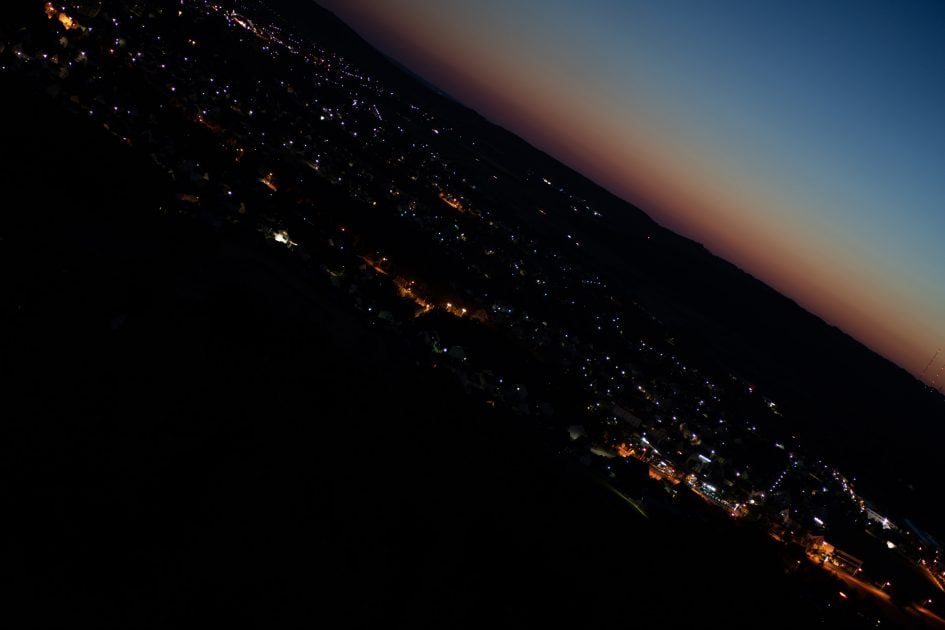
Above: Sony FE 55mm f1.8 ZA at f1.8; click image for 4k version, also available as large original at f1.8, f2.0, f2.8, f4.0, f5.6, f8.0

Above: Sony FE 55mm f1.8 ZA; 100% crops from the FF-corner at f1.8 (left), f2.0 (middle), f2.8 (right)

Above: Sony FE 50mm f1.4 ZA; 100% crops from the FF-corner at f1.4 (left), f2.0 (middle), f2.8 (right)

Above: Sigma 50mm f1.4 Art on a Nikon Z7; 100% crops from the FF-corner at f1.4 (left), f2.0 (middle), f2.8 (right)

Above: Sony FE 50mm f1.8; 100% crops from the FF-corner at f1.8 (left), f2.0 (middle), f2.8 (right)
The Sony FE 55mm f1.8 ZA shows only little coma but it’s still clearly visible when compared to the FE 50mm f1.4 ZA which is practically free of coma, even at f1.4. Both the Sigma Art and the Sony FE 50mm f1.8 show strong coma which is hardly reduced when stopped down to f2.0.
Rendering of out-of-focus point-light sources
This test is for the rendering of point-light sources in an out-of-focus background. The circle of confusion that is produced by this test is pretty indicative of Bokeh performance (in the background) and light fall-off. Ideally the out-of-focus image of the point-light is evenly lit and perfectly circular, with no “onion-rings”, and without coloration. Large aperture lenses normally produce an effect known as “cat’s eye” the further away from the optical axis the point-light is projected. This is due to optical vignetting in the lens barrel when light enters the lens from an angle.
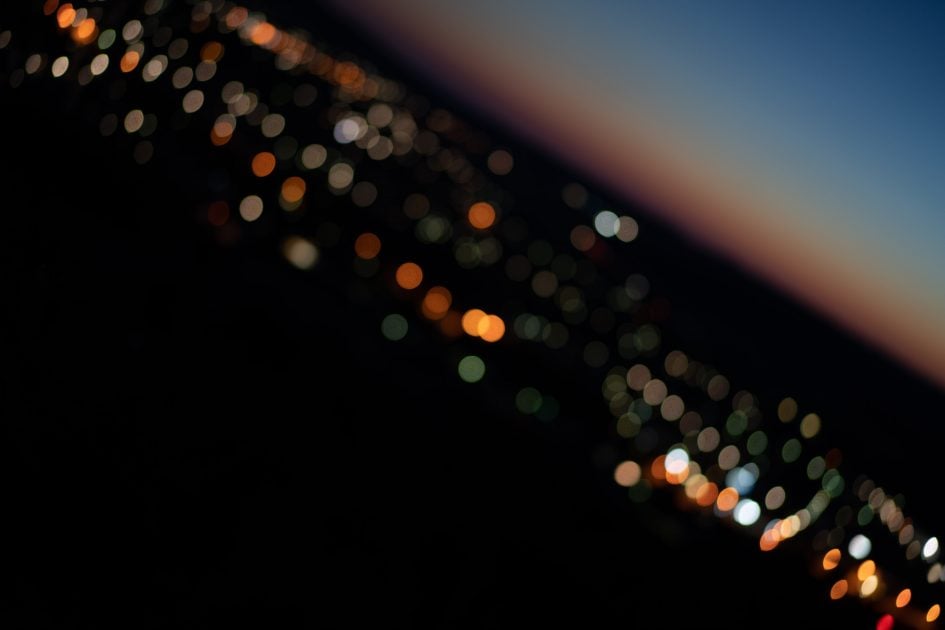
Above: Sony FE 55mm f1.8 ZA at f1.8; click image for 4k version, also available as large original at f1.8, f2.0, f2.8, f4.0, f5.6, f8.0

Above: Sony FE 55mm f1.8 ZA at f1.8; 46% crops from center, APS-C-corner, FF-corner

Above: Sony FE 50mm f1.4 ZA at f1.4; 46% crops from center, APS-C-corner, FF-corner; click image for 4k version, also available as large original at f1.4, f2.0, f2.8, f4.0, f5.6, f8.0

Above: Sigma 50mm f1.4 Art on a Nikon Z7 at f1.4; 44% crops from center, APS-C-corner, FF-corner; click image for 4k version, also available as large original at f1.4, f2.0, f2.8, f4.0, f5.6, f8.0

Above: Sony FE 50mm f1.8 at f1.8; 46% crops from center, APS-C-corner, FF-corner; click image for 4k version, also available as large original at f1.8, f2.0, f2.8, f4.0, f5.6, f8.0
The Bokeh balls of the Sony FE 55mm f1.8 ZA in the center are only a little smaller than from the 50mm f1.4 lenses, helped by the 10% larger magnification of its 55mm focal length. But they show some onion rings and are not as smoothly textured as from the FE 50mm f1.4 ZA and the Sigma Art. The cat’s-eye effect is a bit more pronounced than from the other lenses. But light distribution across the Bokeh ball is pretty even with no hot-spots and only little outlining. The best performance here is from the Sigma Art and the Bokeh from the Sony FE 50mm f1.8 should be the most nervous.
Let’s see how this analysis of out-of-focus point-light sources translates into Bokeh-performance shooting a book-shelf.
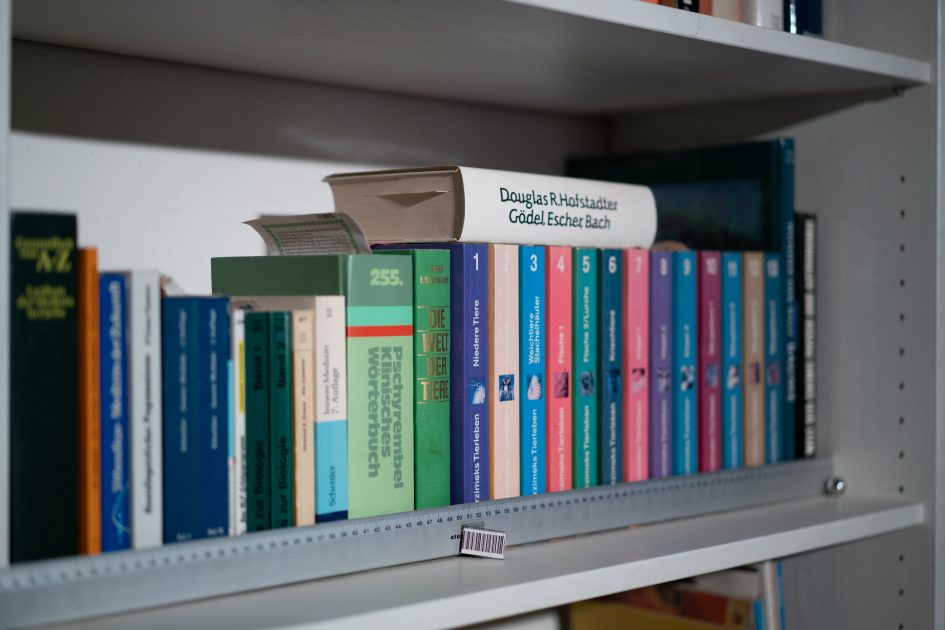
Above: Sony FE 55mm f1.8 ZA at f1.8; click image for 4k version, also available as large original at f1.8, f2.0, f2.8, f4.0, f5.6, f8.0

Above: Sony FE 55mm f1.8 ZA at f1.8; 46% crops from foreground, middle-ground, background

Above: Sony FE 50mm f1.4 ZA at f1.4; 46% crops from foreground, middle-ground, background; click image for 4k version, also available as large original at f1.4, f1.6, f1.7, f2.0, f2.8, f4.0, f5.6, f8.0

Above: Sigma 50mm f1.4 Art on a Nikon Z7 at f1.4; 44% crops from foreground, middle-ground, background; click image for 4k version, also available as large original at f1.4, f1.6, f1.8, f2.0, f2.8, f4.0, f5.6, f8.0

Above: Sony FE 50mm f1.8 at f1.8; 46% crops from foreground, middle-ground, background; click image for 4k version, also available as large original at f1.8, f2.0, f2.8, f4.0, f5.6, f8.0
As already expected from the last comparison the Sigma Art has the best Bokeh in the background and in the transition zone while the Sony FE 50mm f1.8 has the least desirable Bokeh of the four lenses compared here. Of both Sony ZA lenses the FE 50mm f1.4 ZA has the smoother Bokeh helped by its focal ratio of f1.4.
Portrait performance
55mm focal length may not be the classical choice for portraits on a full-frame camera but the Sony FE 55mm f1.8 ZA can well be used for upper body or full body shots or offers an angle of view equivalent to an 85mm lens on a cropped APS-C sensor. And the background blur at closer shooting distances is nice enough to give it a try. All shots were done from the same position/distance so perspective does not change between shots. But due to the slightly different focal lengths of the lenses and different sensor resolutions of the cameras the images and crops show a little different framing and magnification. There are also some slight focus-differences which inevitably occur when you shoot a living, breathing subject.
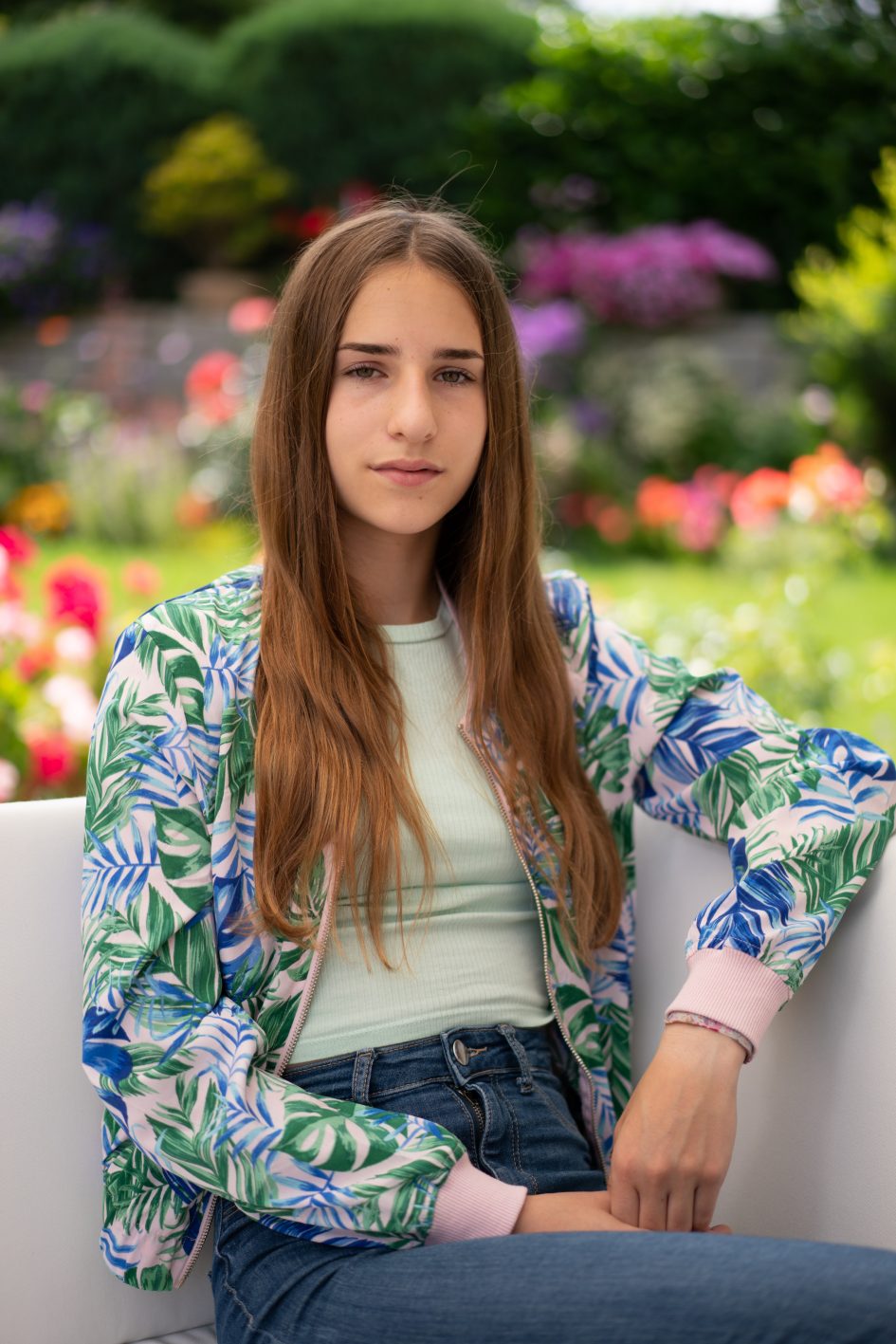
Above: Sony FE 55mm f1.8 ZA at f1.8; click image for 4k version, also available as large original at f1.8, f2.0, f2.8

Above: Sony FE 55mm f1.8 ZA at f1.8, 50% crop; click image to view 100% crop, also available as large original at f1.8, f2.0, f2.8

Above: Sony FE 50mm f1.4 ZA at f1.4, 50% crop; click image to view 100% crop, also available as large original at f1.4, f1.7, f2.0, f2.8

Above: Sigma 50mm f1.4 Art on a Nikon Z7 at f1.4, 50% crop; click image to view 100% crop, also available as large original at f1.4, f1.8, f2.0, f2.8

Above: Sony FE 50mm f1.8 at f1.8, 50% crop; click image to view 100% crop, also available as large original at f1.8, f2.0, f2.8
Background blur is the nicest from the Sigma Art which also produces a pretty smooth transition in the model’s hair. Second are both Sony ZA lenses which render the background a bit nervous – the Sony FE 50mm f1.4 ZA looking even a bit more nervous than the FE 55mm f1.8 ZA. Last one is the FE 50mm f1.8.
Flare and ghosting
Catching a strong light-source shining directly into the lens is always a risky business: it could produce strange colorful ghost-images or reduce contrast considerably through flare and glare. The appearance of flare and ghosting depends on factors like the aperture and the angle of the light hitting the lens. So to judge the proclivity of the Sony FE 55mm f1.8 ZA for these artifacts I went through a series of well calculated shots against a strong light source to provoke glare and ghosting.
The Sony FE 55mm f1.8 ZA is not very prone to flare and ghosting artefacts. The following image at f11 is one of the most obvious examples:

Above: Flare and ghosting. Strong light hitting the Sony FE 55mm f1.8 ZA at f11; click image for 4k version
The little square inset in the upper left of the image shows the respective area with an exposure compensation of +3 EV to make it easier to see which levels of black the lens renders at that point. It clearly shows that the Sony FE 55mm f1.8 ZA renders a very deep black against contra light. Just beware when the light is just outside the corner: it might produce a nasty streak. But this happens only in a very narrow angle:

Above: Flare and ghosting. Strong light hitting the Sony FE 55mm f1.8 ZA at f11; click image for 4k version
All-in-all the Sony FE 55mm f1.8 ZA let’s you shoot confidently under adverse contra-light situations.
Next check out my sample images!
Check prices on the Sony FE 55mm f1.8 ZA at Amazon, B&H, Adorama, or Wex. Alternatively get yourself a copy of my In Camera book or treat me to a coffee! Thanks!

